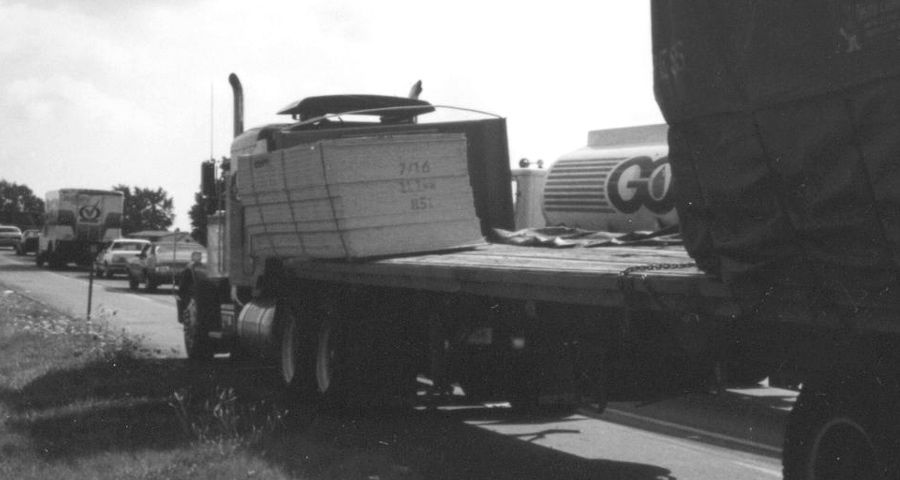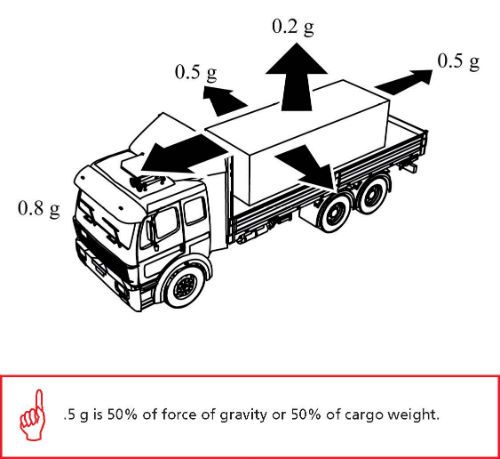Review Questions - Click On The Picture To Begin...

When calculating directional forces, 'g' is expressed as:
- The maximum load that may be applied to a component of a cargo securement system during normal service, usually assigned by the manufacturer of the component.
- The summation of the working load limits or restraining capacity of all devices used to secure an article on a vehicle.
- The maximum load that may be applied to a component of a cargo securement system during normal service, usually assigned by the manufacturer of the component.
- The acceleration due to gravity, 9.823 m/sec2 (32.2 ft/sec2). For cargo securement purposes it is expressed as a percentage of cargo weight, i.e. .5g is 50% of force of gravity or 50% of cargo weight.
Quote From The CDL Manual:
g:
The acceleration due to gravity, 9.823 m/sec2 (32.2 ft/sec2). For cargo securement purposes it is expressed as a percentage of cargo weight, i.e. .5g is 50% of force of gravity or 50% of cargo weight.
Next
Cargo securement for a load weighing 37,000 lbs must be able to withstand a minimum forward braking force of:
- 7,400 lbs
- 18,500 lbs
- 10,000 lbs
- 29,600 lbs
Quote From The CDL Manual:
How well must the securement system work? (Section 1.3)
Each cargo securement system must be able to withstand a minimum amount of force in each direction.
- Forward Force = 80% of cargo weight when braking while driving straight ahead.
- Rearward Force = 50% of cargo weight when accelerating, shifting gears while climbing a hill, or braking in reverse.
- Sideways Force = 50% of cargo weight when turning, changing lanes, or braking while turning.
-
Upward Force = 20% of cargo weight when traveling over bumps in the road or cresting a hill.
- This requirement is satisfied when the cargo is "Fully Contained."
TruckingTruth's Advice:
37,000 x 80% = 29,600 lbs.
Prev
Next
What is the minimum amount of rearward force that a cargo securement system must withstand?
- 100% of cargo weight
- 50% of cargo weight
- 20% of cargo weight
- 80% of cargo weight
Quote From The CDL Manual:
Each cargo securement system must be able to withstand a minimum amount of force in each direction.
- Forward Force = 80% of cargo weight when braking while driving straight ahead.
- Rearward Force = 50% of cargo weight when accelerating, shifting gears while climbing a hill, or braking in reverse.
- Sideways Force = 50% of cargo weight when turning, changing lanes, or braking while turning.
-
Upward Force = 20% of cargo weight when traveling over bumps in the road or cresting a hill.
- This requirement is satisfied when the cargo is "Fully Contained."
Prev
Next
If you were instructed to 'tarp' a load, what would you be using?
- A short piece of material, usually wood, nailed to the deck to reinforce blocking.
- A strip of material that may be used to unitize articles and is tensioned and clamped or crimped back upon itself.
- A platform or tray on which cargo is placed so that it can be handled as an article.
- A waterproof sheet used to cover cargo.
Quote From The CDL Manual:
Tarp:
A waterproof sheet used to cover cargo.
Prev
Next
What is a headboard?
- A vertical barrier across the front of the deck of a vehicle to prevent forward movement of cargo.
- A vertical barrier across a vehicle to prevent forward movement of cargo.
- A transverse load bearing structural component, particularly a part of a log bunk.
- A vertical barrier placed directly behind the cab of a tractor to protect the cab in the event cargo should shift forward.
Quote From The CDL Manual:
Headboard:
A vertical barrier across the front of the deck of a vehicle to prevent forward movement of cargo.
Prev
Next
While driving, the freight must not:
- Obscure the driver's view ahead, left, or right.
- Prevent the exit of a person from the cab.
- Interfere with the free movement of the driver's arms or legs.
- All of these things should be avoided.
Quote From The CDL Manual:
The cargo or any other object must not:
- Obscure the driver's view ahead or to the right or left sides (except for drivers of self-steer dollies).
- Interfere with the free movement of the driver's arms or legs.
- Prevent the driver's free and ready access to accessories required for emergencies. OR
- Prevent the free and ready exit of any person from the commercial motor vehicle's cab or driver's compartment.
Prev
Finish
Please select an option





 Related Cargo Securement Terms That Every Driver Should Know:
Related Cargo Securement Terms That Every Driver Should Know: 



 TT On Facebook
TT On Facebook